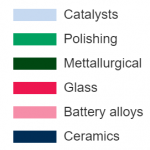Rare Earth Elements

Rare earth minerals, comprising 17 elements with unique physical and chemical properties, are pivotal in cutting-edge technologies and clean energy applications (e.g. electric vehicles and wind turbines). Their magnetic, catalytic, and luminescent properties fuel innovation across electronics, renewable energy, defence, and healthcare. Despite the name [rare], REE’s have relatively high crustal abundance, but economic concentrations are scarce. China’s dominance in production raises global supply chain concerns, driving exploration into sustainable mining and recycling methods whilst increasing market players. Balancing technological strides with environmental responsibility is critical for this sector’s growth and global accessibility.
Wednesday, 26 April 2023
| Metal | Price RMB/mt |
| Lanthanum oxide | 6,650 |
| Cerium oxide | 6,800 |
| Praseodymium oxide | 545,000 |
| Neodymium oxide | 570,000 |
| Samarium oxide | 15,000 |
| Europium oxide | 195 |
Thematic Subject
Rare Earth Elements
| Metal | Price RMB/mt |
| Gadolinium oxide | 272,500 |
| Terbium oxide | 9,650 |
| Dysprosium oxide | 2,010 |
| Erbium oxide | 257,500 |
| Yttrium oxide | 49,500 |
| NdPr oxide | 535,000 |
Rare Earth Elements
Sector Research
Analyst Team
+44 20 7419 7928
extractives@acfequityresearch.com
Permanent Magnets to Lead REE Market
Rare Earth Elements (REEs) are key to the new clean energy economy. REEs are a set of 17 elements with unique physical and chemical properties used across a range of industrial and technological applications. The largest use of REEs is the production of permanent magnets – a critical component of clean energy applications (e.g., electric vehicles and wind turbines). We expect strong demand gr% in 22-32E for magnet rare earths, including neodymium, praseodymium and dysprosium.
REE Market Value – $2.60 bn in 2020A
REE Market Value – $4.38 bn by 2025E
REE Market Value – $7.38 bn by 2030E
Demand for REEs
From 2015-20, the consumption of rare earths minerals has grown by an estimated 3.9% per year, according to the Australian Department of Industry, Science, Energy and Resources. We expect the demand to grow faster in the next decade driven by clean energy applications where REEs are critical components. Demand is forecasted to grow at 5% per annum until 2030 to nearly 272,000 Mt, vs. approximately 167,000 Mt in 2020 (as per Arafura Resources).
Global consumption of REEs by application 2021A %
REEs largest consumption (demand) application is in magnets (for use in wind turbines, and electric vehicle motors), which accounted for 26% of total REE consumption in 2019, according to US
Geological Survey. Magnet consumption is followed by metal alloys (for use in batteries, fuel cells) at
19% of total consumption, polishing (16.5%) and for catalysts used in oil refineries and automobiles (15.5%).
The substantial dependence on China, which accounts for more than 50% of world’s rare earth production, makes other countries strategically vulnerable, especially if China decides to restrict
exports to a particular country.
The dominance of China within the rare earths market has forced many countries to look for ways to diversify their supply chains. This includes making direct investments locally to build rare earth mining projects.
















